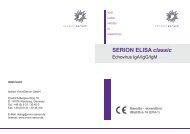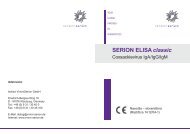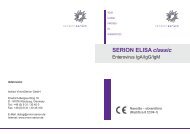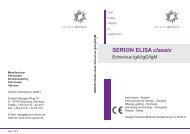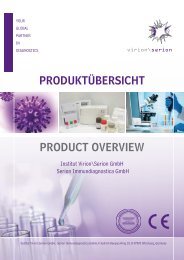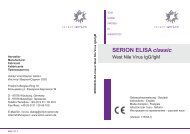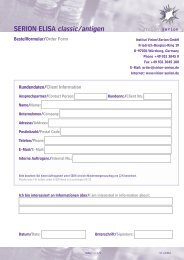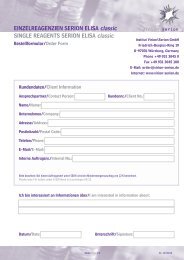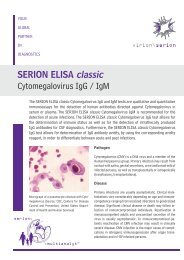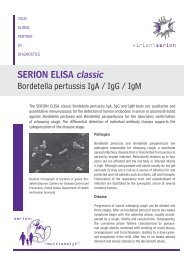Create successful ePaper yourself
Turn your PDF publications into a flip-book with our unique Google optimized e-Paper software.
Pos: 8 /Arbeitsanl eitung en ELISA classi c/Gültig für alle D okumente/ELISA cl assic/T estprinzip/Testpri nzip ELISA classic @ 4\mod_1255342796551_18.doc @ 21208 @ 1The infection levels tend to follow the winter season. Whilst in the northern hemisphere theinfection rate peaks between October and March, in the southern hemisphere the seasonis between May and September. The symptoms of infection are variable, ranging fromasymptomatic to acute respiratory distress and death. Sudden onset of symptoms istypical. Classic symptoms develop within a few hours and include fever, cough, headacheas well as muscle aches.Complications are usually seen in individuals suffering from immunosuppression ormetabolic diseases. The feared pneumonia caused by the virus itself, is rarely seen.Usually, pneumonia develops because of a bacterial super-infection, which may penetratethe lower respiratory tract.Direct pathogen detection by PCR or antigen determination from throat andnasopharyngeal swabs is the best method for an early diagnosis. ELISA and IFT systemsare available for direct pathogen/antigen detection. Virus identification in cell culture,followed by immunohistological examination is another alternative.Specific antibody detection using ELISA and CFT assays are reliable methods whichsupport the clinical diagnosis of influenza. In addition, ELISA offers the possibility todistinguish between the different antibody classes. Following the regular course of aprimary infection, all three major immungloblin classes may be detected. Whilst theconcentration of IgA and IgM antibodies are at their maximum two weeks post infection,the level of IgG peaks four to six weeks after onset of symptoms. Further, the reliability ofdetection depends on the correct choice of antigen used in the assay system. By usingstrongly immunogenic components of the virus, such as heamagglutinin or neuraminidase,it is possible to detect antibodies many years post infection (possibly lifelong). However,when using components such as nucleo- (NP) or matrix proteins, only non-neutralizingantibodies are detected and these are generally only present for a few weeks or monthsfollowing resolution of infection.ENEL ENCS PTSERION ELISA classic <strong>Influenza</strong> A and B Virus IgA, IgG and IgM tests are based onconserved antigens such as nucleo- and matrix proteins. This allows for the detection ofantibodies independent from the infecting subtype. Due to the fact that antibodies whichare directed against these epitopes usually fall to undetectable levels shortly after theresolution of infection, these tests allow for an improved differentiation between acutecurrent infection and convalescence.english 3




